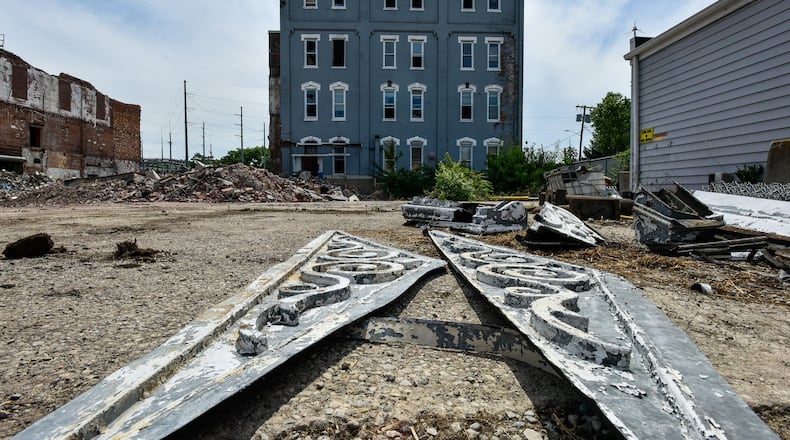“Whatever we can get off of the building, we’re just trying to preserve some of the history,” said Snyder, whose company is working on about eight projects inside Hamilton now, including the under-restoration building at 642 High St., being redeveloped for century-old Vision Source Hamilton.
The blue former office building was constructed in 1890. Those who have been inside it, like Snyder and Kathy Creighton, executive director of the Butler County Historical Society, say the inside, including its wooden plank floors, were impressed before it was damaged by the elements.
“Personally, it’s a little upsetting” to see the building torn down, Snyder said. “But if there isn’t an end use, and you can’t find a buyer, you’ve got to continue to move forward.”
The building was the longtime property of Beckett Paper. It most recently was operated by Mohawk Fine Papers until 2012.
In September 2017, then-owner Simfall LLC, based in Lockport, N.Y., put a request on hold to demolish the bluish brick building so a plan could be created to redevelop the industrial site, which is located right next to the north-south railroad tracks that run past the area.
Redevelopment was made more difficult by noise from the frequent passing trains.
“It is incredibly disappointing to lose a building of such historic significance,” said City Manager Joshua Smith. “It becomes more important that we collaborate and find ways to maintain the two prominent brick structures that are adjacent to MLK.”
The city’s Nuisance Appeals Board, which was concerned that the property was not properly secured from intruders, in February directed the owner to board up all ground-level openings as soon as possible, provide a remediation plan for the building and submit a report from a structural engineer stating the smokestack is stable.
Because the city’s health commissioner had declared the property a public nuisance, approval from the city’s Architectural Design Review Board was not required, the board also informed the owners.
“At least we can salvage, and save parts of the building and keep some of these in circulation,” Snyder said. “We’ve done quite a bit of salvage work.”
For example, two doors that were removed from walk-in Mosler safes in the building at 201 Main St. that is being redeveloped into the Billy Yanks restaurant are being repurposed for use at the Vision Source Hamilton building.
Snyder was impressed with craftsmanship involved with corbels that workers removed from the building. A corbel is a bracket on a wall that holds up something above it, such as a part of the roof.
Craftsmen 130 years ago cut metal and soldered it together in intricate ways, Snyder said about one architectural piece: “There’s so much work, and so much detail, and craftsmanship that went into each of these pieces.”
These days, parts like that are made using “molds and styrofoam,” he said.
He said he has created pieces of bars in Cincinnati’s Over-the-Rhine neighborhood with salvaged parts.
“Bars and restaurants like to repurpose a lot of this,” for bar tops, bar faces, and shelves behind bars, he said. “And anytime they can get authentic pieces that actually have a story, or a history to them, they’re more sought after.”
“Hopefully we keep them in town, but we’d never know if we let them go to the landfill,” he said.
About the Author
